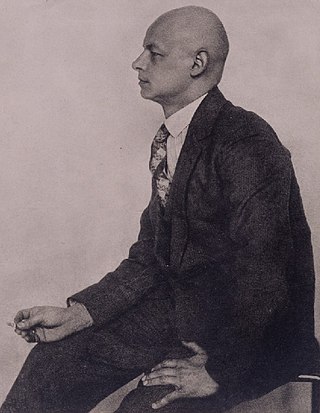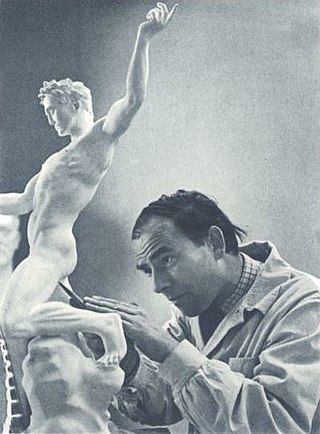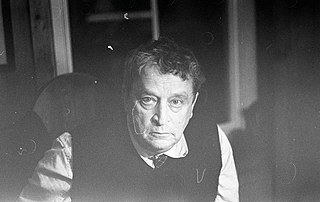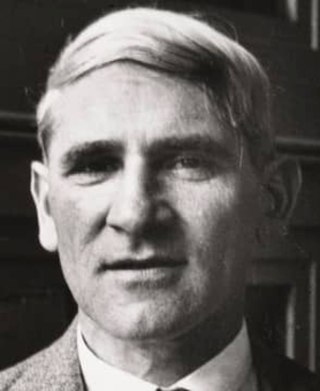
Alf Bayrle (15 December 1900 – 11 September 1982), also known as Alf Singer-Bayrle, was a German painter, printmaker and sculptor.

Alf Bayrle (15 December 1900 – 11 September 1982), also known as Alf Singer-Bayrle, was a German painter, printmaker and sculptor.
Bayrle was born in Biberach an der Riss. After his military service and participation in the First World War, he studied from 1918 to 1922 at the Stuttgart Academy at the classes of Adolf Hölzel, Robert Poetzelberger, Gottfried Graf, Arnold Waldschmidt and at the School of Applied Arts in classes of Heinrich and Friedrich Schneidler. That time was the beginning of his friendship with Willi Baumeister and Oskar Schlemmer. In Schlemmer's Triadic Ballet, he participated later and organized the Paris show in 1932.
In 1922 he moved to Munich and continued his studies until 1925. There he studied at Franz von Stuck at the Academy, Hans Hofmann at the School of Fine Arts and took additional lessons from Heinrich Wölfflin at the University. In 1923 and 1924 as a student in Munich he wrote about "the lack of understanding of modern art".
In 1926 he moved to Paris and worked there as a painter, at the same time he also studied at the Académie de la Grande Chaumière (at Othon Friesz and André Lhote). His friends in Paris at that time included Colette, André Derain, Rene Jurdain, Paul Poiret, Maurice Ravel. Bayrle followed the invitation of Rene Jurdain to share his studio space, from 1928 to 1934, however, he spent in summertime months in St. Tropez at Madame Aude. In Paris he was in contact with Giorgio de Chirico, Jean Cocteau, Le Corbusier, Raoul Dufy, Aristide Maillol, Henri Matisse and Pablo Picasso. Although an active and recognized member of the Parisian art scene his exhibitions there are poorly documented and researched today. In 1927, he had an exhibition with Arno Breker, who also lived in Paris.
In 1934 the Institute of Morphology, run by Leo Frobenius of the University of Frankfurt offered him a position as an artist. The institute offered Bayrle the opportunity to paint without the fear of persecution of the regime. In the same year Frobenius and Bayrle made their first expedition to Africa. Two years later their book about South Abessinia was published which contains 40 plates in photogravure prints of drawings of Alf Bayrle. Until today these drawings, as well as the unpublished have a great importance from a scientific, ethnographic and artistic point of view. Some other expeditions were made to the South of France, Spain, Libya and Ethiopia.
In 1937 the work-up of the expeditions was finished and Bayrle moved to Berlin, where 7 November 1937, where his son Thomas Bayrle was born, he became also a painter. In 1939 he was drafted into the military and was taken prisoner. The 1943–44 bombing destroyed much of his recent works. In 1948 he was released from war captivity and moved to Frankfurt and opened a studio there, he was a member of the Professional Association of Visual Artists Frankfurt. In the early postwar period, next to his artistic activity he made scenes and decorations, and taught as an art teacher at the Gutenberg school. His studio was at the Röderbergweg in Frankfurt (near the Zoo) in the same house with his son's studio. In 1966 he opened a second studio in Bonn and in 1968 was a founder member of the artist group "semicolon" and a member of the Artist Group Bonn. Bayrle never wanted a retrospective of his work, so the great exhibition in 1980 showed mostly contemporary works. Alf Bayrle died in 1982 in Rotthalmünster.
When the German author Adam Seide published his novel "Rebecca" in 1987 he dedicated it in memory of the painter Alf Bayrle.
Unlike several of his avant-garde contemporaries, Bayrle rejected non-representational painting; instead, he took up and advanced the tradition of figurative painting. His work was influenced by his time with Hans Hofmann, the artists circles in Paris and the expeditions to Africa. During his time in Paris he often painted still life.
Bayrles solo exhibition in 1925, shows figurative works inspired by impressionism. His chief interest was even at this time already in cubism and Paul Cézanne, whose work remained important to him throughout his life. Sina Hofmann Ginsburg and Karla Bilang confirmed "a strong Cezannism" in the work of Alf Bayrle.
Much of his early work was destroyed by bombing, a fortunate circumstance is that he had sold a lot in the 1920s and 1930s. He discovered as a visitor in 1967, the still life "plant with pineapple" in the exhibition of the Kazimir Hagen collection, which he had painted in Paris in 1929. The Africa-topic influenced him even after the expeditions especially his late work. He started a collection of African art and antiques which he had to sell in the late 1940s.
One single known work "Vom Bau des Atlantikwalls" from 1940 ("Building a Bunker, Atlantic Wall" in the Portland Art Museum [1] ) shows a scene from his military service.
His late work was focused on heads, which he drew in many ways mostly in ink. They represent various emotions and characters and are characteristic for his turn away from classic portraiture. He signed his works with Bay and in some cases with his full name, some sketches and designs he left unsigned.
Little known is his work as a graphic designer: His poster "Der Reichskolonialbund ruft auch Dich!" (The Reichskolonialbund calls also you) from 1938 is part of the permanent collection of the Victoria and Albert Museum in London [2] and in the collection of the University of California, Berkeley.

Max Ernst was a German painter, sculptor, printmaker, graphic artist, and poet. A prolific artist, Ernst was a primary pioneer of the Dada movement and Surrealism in Europe. He had no formal artistic training, but his experimental attitude toward the making of art resulted in his invention of frottage—a technique that uses pencil rubbings of textured objects and relief surfaces to create images—and grattage, an analogous technique in which paint is scraped across canvas to reveal the imprints of the objects placed beneath. Ernst is noted for his unconventional drawing methods as well as for creating novels and pamphlets using the method of collages. He served as a soldier for four years during World War I, and this experience left him shocked, traumatised and critical of the modern world. During World War II he was designated an "undesirable foreigner" while living in France.

André Derain was a French artist, painter, sculptor and co-founder of Fauvism with Henri Matisse.
Abstract Expressionism in the United States emerged as a distinct art movement in the immediate aftermath of World War II and gained mainstream acceptance in the 1950s, a shift from the American social realism of the 1930s influenced by the Great Depression and Mexican muralists. The term was first applied to American art in 1946 by the art critic Robert Coates. Key figures in the New York School, which was the epicenter of this movement, included such artists as Jackson Pollock, Franz Kline, Mark Rothko, Norman Lewis, Willem de Kooning and Theodoros Stamos among others.

Color field painting is a style of abstract painting that emerged in New York City during the 1940s and 1950s. It was inspired by European modernism and closely related to abstract expressionism, while many of its notable early proponents were among the pioneering abstract expressionists. Color field is characterized primarily by large fields of flat, solid color spread across or stained into the canvas creating areas of unbroken surface and a flat picture plane. The movement places less emphasis on gesture, brushstrokes and action in favor of an overall consistency of form and process. In color field painting "color is freed from objective context and becomes the subject in itself."

Oskar Schlemmer was a German painter, sculptor, designer and choreographer associated with the Bauhaus school.

Hans Hofmann was a German-born American painter, renowned as both an artist and teacher. His career spanned two generations and two continents, and is considered to have both preceded and influenced Abstract Expressionism. Born and educated near Munich, he was active in the early twentieth-century European avant-garde and brought a deep understanding and synthesis of Symbolism, Neo-impressionism, Fauvism, and Cubism when he emigrated to the United States in 1932. Hofmann's painting is characterized by its rigorous concern with pictorial structure and unity, spatial illusionism, and use of bold color for expressive means. The influential critic Clement Greenberg considered Hofmann's first New York solo show at Peggy Guggenheim’s Art of This Century in 1944 as a breakthrough in painterly versus geometric abstraction that heralded abstract expressionism. In the decade that followed, Hofmann's recognition grew through numerous exhibitions, notably at the Kootz Gallery, culminating in major retrospectives at the Whitney Museum of American Art (1957) and Museum of Modern Art (1963), which traveled to venues throughout the United States, South America, and Europe. His works are in the permanent collections of major museums around the world, including the Metropolitan Museum of Art, Tate Modern, Germanisches Nationalmuseum, National Gallery of Art, and Art Institute of Chicago.

Arno Breker was a German architect and sculptor who is best known for his public works in Nazi Germany, where they were endorsed by the authorities as the antithesis of degenerate art. He was made official state sculptor, and exempted from military service. One of his better known statues is Die Partei, representing the spirit of the Nazi Party that flanked one side of the carriage entrance to Albert Speer's new Reich Chancellery.
Wolf Kahn was a German-born American painter.

Sir Norman Rosenthal is a British independent curator and art historian. From 1970 to 1974 he was Exhibitions Officer at Brighton Museum and Art Gallery. In 1974 he became a curator at the Institute of Contemporary Arts, London, leaving in 1976. The following year, in 1977, he joined the Royal Academy in London as Exhibitions Secretary where he remained until his resignation in 2008. Rosenthal has been a trustee of numerous different national and international cultural organisations since the 1980s; he is currently on the board of English National Ballet. In 2007, he was awarded a knighthood in the Queen's Birthday Honours List. Rosenthal is well known for his support of contemporary art, and is particularly associated with the German artists Joseph Beuys, Georg Baselitz, Anselm Kiefer and Julian Schnabel, the Italian painter Francesco Clemente, and the generation of British artists that came to prominence in the early 1990s known as the YBAs.

Ralf Winkler, alias A. R. Penck, who also used the pseudonyms Mike Hammer, T. M., Mickey Spilane, Theodor Marx, "a. Y." or just "Y" was a German painter, printmaker, sculptor, and jazz drummer. A neo-expressionist, he became known for his visual style, reminiscent of the influence of primitive art.
Triadisches Ballett is a ballet developed by Oskar Schlemmer. The ballet became the most widely performed avant-garde artistic dance and while Schlemmer was at the Bauhaus from 1921 to 1929, the ballet toured, helping to spread the ethos of the Bauhaus.

Willi Baumeister was a German painter, scenic designer, art professor, and typographer. His work was part of the art competitions at the 1928 Summer Olympics and the 1932 Summer Olympics.

Otto Freundlich was a German painter and sculptor of Jewish origin. A part of the first generation of abstract painters in Western art, Freundlich was a great admirer of cubism. He was murdered at Majdanek concentration camp during the Holocaust.
Paul Gordon Georges was an American painter. He painted large-scale figurative allegories and numerous self-portraits.
Max Peiffer Watenphul was a German artist. Described as a "lyric poet of painting", he belongs to a "tradition of German painters for whom the Italian landscape represented Arcadia." In addition to Mediterranean scenes, he regularly depicted Salzburg and painted many still lifes of flowers. As well as oil paintings, his extensive body of work encompasses watercolours, drawings, enamel, textiles, graphic art, and photographs.

Marg Moll was a German sculptor, painter and author.
Carl Heidenreich (1901-1965) was a German American artist and an important contributor to the Abstract Expressionist movement in New York.
The Ninth German Inner Africa Research Expedition was led by Leo Frobenius to Southern Africa between August 1928 and March 1930. It visited modern-day South Africa, Zimbabwe, Botswana, Lesotho, Mozambique, Namibia and Zambia. It recorded a large quantity of indigenous rock art, which helped Frobenius to build one of the most important collections of such work, some of which was sold to South African museums. It also investigated ancient ore mines and provided samples for some of the first metallographic and chemical analysis of southern African indigenous metals.
Elisabeth Charlotte Pauli was an artist and ethnographer working at the Frobenius Institute in Frankfurt am Main. She participated in several expeditions of the institute as participant and co-organiser, and produced a large number of copies of prehistoric rock art in Europe and Africa. During the Second World War she and three other women acted as the temporary management of the institute.

Thomas Bayrle is a German sculptor, painter, graphic artist and video artist. He is known as a pop artist.